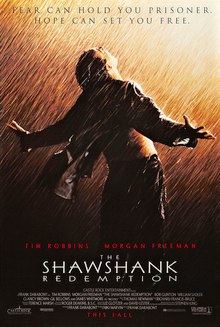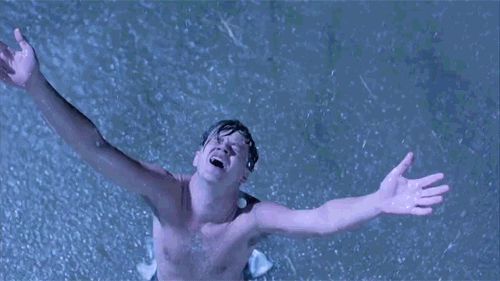Kerri Battles the AFI’s Top 100 – #72: The Shawshank Redemption

This week’s battle is with an old favorite that, if you have even basic cable, you’ve already seen a thousand times (THANKS TNT). I know I have. I’ve watched it in edited bits and pieces — for content, to fit my screen, and to run in the time allotted — more times than I can count, but I honestly couldn’t tell you the last time I watched The Shawshank Redemption unedited from titles to credits before this weekend. I’m sure that I have, but it may have been about 19 years ago, when it was first released on home video. That seems appropriate, anyway, since that’s about how long it took Andy Dufresne to tunnel out of his cell.

Andy Dufresne first enters Shawshank Penitentiary in 1937 after being (wrongfully) convicted and sentenced to life in prison for the murder of his wife and her golf pro lover. In 1939, he first speaks to Ellis Boyd “Red” Redding, a man who knows how to get things, and he likes Andy right from the start. Andy hopes Red can procure him a rock hammer, the sound of which makes Red lays eyes on the laughably small instrument. Andy Dufresne really does just want to make his own chess set out of obsidian and soap stone. Though Andy maintains his innocence at all times, he makes the best of his sentence. He succeeds in rebuilding the prison library and uses the experience of his former life as a fancy suit-wearing banker to get on the good side of the guards and, finally, the warden, who finds Andy’s financial expertise quite useful in his massive money laundering scheme. When new fish Tommy Williams arrives with his greaser pompadour in 1965, Andy takes him under his wing and helps Tommy earn his high school equivalency. When Red tells Tommy the story of woe that put Andy in Shawshank with the rest of them, Tommy looks sick. Finally, he explains — his former cell mate in another prison told him all about the murder of Andy’s wife because he committed it. Andy takes this information directly to the Warden, hoping for some assistance in getting a retrial. The Warden, more concerned with his off-the-books earnings than the fate of a wrongly accused man, has Tommy shot by a guard and reports it as a failed escape attempt. Andy tells Red, who has been denied parole twice, that when he does finally get out, he needs to head to a big field in a small town and locate a large piece of black volcanic glass under a giant oak tree. Andy tells Red there’s something buried there that he must see. When Red asks what it could possibly be, Andy tells him he has to dig it up to find out. Shortly thereafter, Andy escapes through the tunnel he’s spent decades digging out of his cell using only the laughably small rock hammer. He takes with him all the records of the laundered money and the phony identification for the phantom man he created on paper. Rather than face indictment, the Warden takes a bullet to the chin. When Red finally earns parole, he finds that tree, along with a note from Andy and hundreds of dollars. From there, he meets Andy in their tiny seaside dream town in Mexico.

This is the point in the weekly post formula where I usually start to explain what makes this week’s film stand out, for better or for worse. It’s where I’d start arguing for or against the AFI’s choice, hoping to sway you to seek out or avoid the film at all costs. I can’t do that with The Shawshank Redemption. I can’t tell you anything you don’t already know about this story of existentialism and the indomitable human spirit because, thanks to Ted Turner’s network and the otherwise entertainment-free-zone that is Saturday afternoon programming, every last one of you has seen it more times than you can count. You all know Brooks was here. You know Red was originally written as an aging, graying Irish ginger and Morgan Freeman, true to Morgan Freeman form, performed the shit out of that role anyway. You know [insert any other famous 90s leading man’s name here] turned down the role of Andy Dufresne and has been kicking himself ever since. Hell, I probably could have left out the summary paragraph this week and no one would have noticed because the story of Shawshank is so ingrained in our minds. But did you know that this tale of the triumph of hope in the face of all odds was actually a box office flop that never won a single major award and somehow went on to become the film darling of viewer hearts and minds everywhere?

META. AS. FUCK.
Between its initial limited release, official wide release, and Oscar-buzz-generated rerelease, The Shawshank Redemption brought in barely more than its total budget at the box office. It was nominated for seven Oscars, two Golden Globes, and two SAGs, but only cinematographer Roger Deakins brought home a statuette — the American Society of Cinematographers award for Outstanding Achievement in Cinematography. That’s not exactly the type of awards show that gets red carpet coverage on E!. That’s also not exactly the type of results that any Hollywood studio in the business of making money would call a success. Yet, amid all of this ostensible failure, Warner Bros. shipped over 300,000 rental copies to video stores nationwide. Their gambit paid off and The Shawshank Redemption became one of the most highly rented videos of all time. Then, as previously mentioned, Ted Turner stepped in, worked some broadcast-rights-magic, and made it [probably] one of the most viewed films in the history of American cinema. If existentialism is all about rejecting preconceived philosophies and labels in order to determine or define your own meaning behind your existence, then The Shawshank Redemption provides examples of this in both fictional metaphors and the real world.

C’mon, you get it — salvation lies within!
I have only ever met one person on this planet whose official stance on The Shawshank Redemption was “overrated” and that dude was wearing skinny jeans as he uttered those words, so his opinion was already suspect at best. The rest of us have all accepted the film into our Pop Culture Hive Mind as one of the greatest of all time. And it’s not just because the broadcast copyright lapsed without anyone noticing and TV stations everywhere seized the opportunity to air it for free every Christmas (#20, I’m looking at you, you unfettered steaming piece of dung). It’s because of all the reasons you already know. It’s because, even on the surface as well as deep below, it’s a story that reminds us all why it’s important to find our own meaning and joy in life in spite of what hardships we might face. It’s because, in less than 2 and a half hours, you’re warmly reminded of the one simple fact of all life that Andy Dufresne states so succinctly. Get busy living or get busy dying. — KSmith
